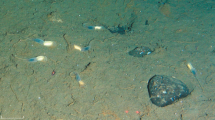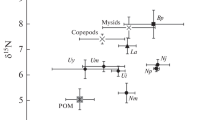Abstract
Foregut contents of calyptopes (the first feeding stage) ofEuphausia pacifica Hansen, collected from the Yellow Sea in June 1989, were examined using scanning electron microscopy with the dry-fracturing method. There was no clear evidence of phytoplankton ingestion by calyptopes. The foregut contents consisted entirely of amorphous organic detritus, crustacean remains and inorganic particles. The inorganic particles adhered to amorphous organic detritus, and bacterial populations were found on peritrophic membranes of fecal pellets which enveloped crustacean remains. These materials seemed to have originated from aggregates of organic and inorganic detritus. It is quite possible that the detrital aggregates are utilized extensively as food by calyptopes ofE. pacifica in the Yellow Sea.
Similar content being viewed by others
Literature cited
Alldredge, A.L. (1972). Abandoned larvacean houses: a unique food source in the pelagic environment. Science, N.Y. 177: 885–887
Alldredge, A. L. (1976). Discarded appendicularian houses as sources of food, surface habitats, and particulate organic matter in planktonic environments. Limnol. Oceanogr. 21: 14–23
Alldredge, A. L., Silver, M. W. (1988). Characteristics, dynamics and significance of marine snow. Prog. Oceanogr. 20: 41:82
Anger, K., Dawirs, R. R. (1981). Influence of starvation on the larval development ofHyas araneus (Decapoda, Majidae). Helgoländer Meeresunters. 34: 287–311
Banse, K. (1990). New views on the degradation and disposition of organic particles as collected by sediment traps in the open sea. Deep-Sea Res. 37: 1177–1195
Dawirs, R. R. (1987). Influence of limited starvation periods on growth and elemental composition (C, N, H) ofCarcinus maenas (Decapoda: Portunidae) larvae reared in the laboratory. Mar. Biol. 93: 543–549
Gowing, M. M., Silver, M. W. (1985). Minipellets: a new and abundant size class of marine fecal pellets. J. mar. Res. 43: 395–418
Hamner, W. M., Hamner, P. P., Obst, B. S., Carleton, J. H. (1989). Field observations on the ontogeny of schooling ofEuphausia superba furciliae and its relationship to ice in Antarctic waters. Limnol. Oceanogr. 34: 451–456
Johnson, B. D., Cooke, R. C. (1980). Organic particle and aggregate formation resulting from the dissolution of bubbles in seawater. Limnol. Oceanogr. 25: 653–661
Lasker, R. (1966). Feeding, growth, respiration, and carbon utilization of a euphausiid crustacean. J. Fish. Res. Bd. Can. 23: 1291–1317
Marschall, H.-P. (1985). Structural and functional analyses of the feeding appendages of krill larvae. In: Siegfried, W. R., Condy, P. R., Laws, R. M. (eds.) Antarctic nutrient cycles and food webs. Springer-Verlag, Berlin, p. 346–354
Mauchline, J. (1980). The biology of euphausiids. Adv. mar. Biol. 18: 373–623
Mauchline, J., Fisher, L. R. (1969). The biology of euphausiids. Adv. mar. Biol. 7: 1–454
May, R. C. (1974). Larval mortality in marine fishes and the critical period concept. In: Blaxter, J. H. S. (ed.) The early life history of fish. Springer-Verlag, Berlin, p. 3–19
McCave, I. N. (1984). Size spectra and aggregation of suspended particles in the deep ocean. Deep-Sea Res. 31: 329–352
Nemoto, T. (1967). Feeding pattern of euphausiids and differentiations in their body characters. Inf. Bull. Planktol. Japan, Comm. Number of Dr. Matsue: 157–171
Ohman, M. D. (1984). Omnivory byEuphausia pacifica: the role of copepod prey. Mar. Ecol. Prog. Ser. 19: 125–131
Ritz, D. A., Hosie, G. W., Kirkwood, R. J. (1990). Diet ofNyctiphanes australis Sars (Crustacea: Euphausiacea). Aust. J. mar. Freshwat. Res. 41: 365–374
Ross, R. M. (1981). Laboratory culture and development ofEuphausia pacifica. Limnol. Oceanogr. 26: 235–246
Ross, R. M., Quetin, L. B. (1989). Energetic cost to develop to the first feeding stage ofEuphausia superba Dana and the effect of delays in food availability. J. exp. mar. Biol. Ecol. 133: 103–127
Sheldon, R. W., Evelyn, T. P. T., Parsons, T. R. (1967). On the occurrence and formation of small particles in seawater. Limnol. Oceanogr. 12: 367–375
Toda, T., Suh, H.-L., Nemoto, T. (1989). Dry fracturing: a simple technique for scanning electron microscopy of small crustaceans and its application to internal observations of copepods. J. Crustacean. Biol. (Lawrence, Kansas) 9: 409–413
Youngbluth, M. J. (1982). Utilization of a fecal mass as food by the pelagic mysis larva of the penaeid shrimpSolenocera atlantidis. Mar. Biol. 66: 47–51
Author information
Authors and Affiliations
Additional information
Communicated by M. Anraku, Suva
Rights and permissions
About this article
Cite this article
Suh, H.L., Toda, T. & Terazaki, M. Diet of calyptopes of the euphausiidEuphausia pacifica in the Yellow Sea. Mar. Biol. 111, 45–48 (1991). https://doi.org/10.1007/BF01986344
Accepted:
Issue Date:
DOI: https://doi.org/10.1007/BF01986344




